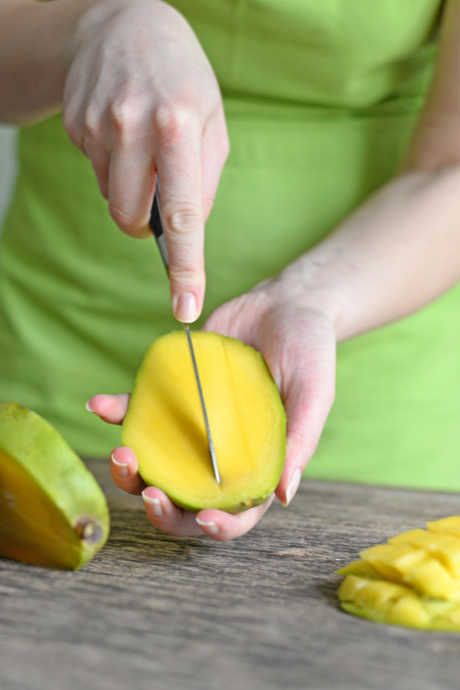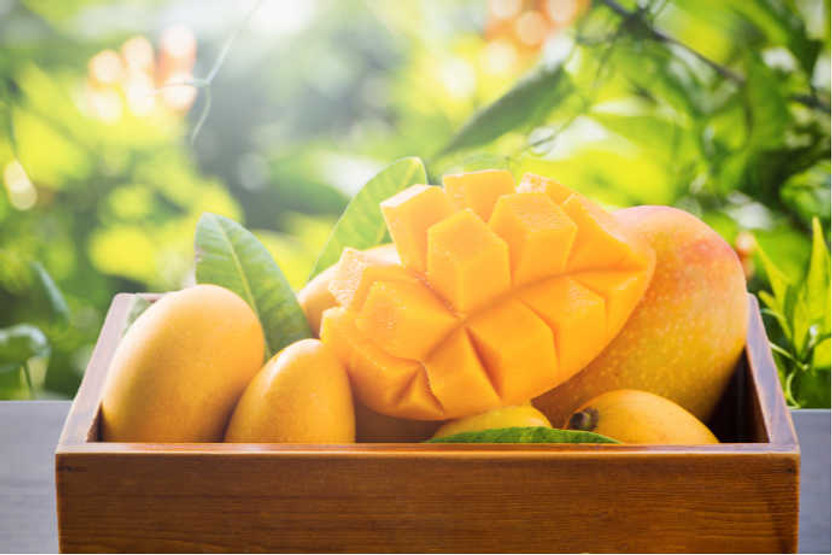Learn to Love the Mysterious Mango
Posted by Julie on Jun 10th 2019
Mangoes are such a misunderstood fruit. Many people aren’t sure how to tell when a mango is ripe. They’re confounded by how to extract the flat pit. The texture is often tough, and the taste can be underwhelming. It’s no wonder we don’t eat them more frequently. In this post, we’ll unravel the mystery of mangoes. Learn to distinguish between mango varieties, gauge their ripeness, and turn them into a delicious dish.
How to Choose a Mango
Don’t judge a mango by its color unless you know what variety it is, and what different colors mean for that variety. The National Mango Board explains that going by feel is the best approach. A ripe mango will be a bit soft, like ripe peaches and avocados. You can also sniff the fruit, just as you would with pineapple.

Your best bet for sourcing high quality mangoes will be an Asian grocery, especially one that specializes in Indian foods. Mangoes are also frequently found in supermarkets, but the variety usually sold there -- known as Tommy Atkins -- isn’t preferred by mango connoisseurs. More on mango varieties in a bit.
Similar to peaches and avocados, you can buy not-fully-ripe mangoes and allow them to ripen further at home. Pop them into a paper bag or cover them with a towel, but don’t put them in the refrigerator until they’re ripe. They’ll keep in the refrigerator for nearly a week.
How to Cut a Mango
The elusive mango pit is a big part of the mystery of this fruit. Step-by-step photographs and videos abound to demonstrate how to cut a mango and extract the pit without losing too much of the flesh. Slice the mango on either side of the midline, eliminating about a 1/2-inch section with the stem at the top. That’s the pit; the rest of the mango is edible. Then score each half of the mango into cubes, as you might do with an avocado, and scoop the flesh out of the skin. If your mango is ripe, the flesh will release easily.

We advise you to toss or compost the mango skin. Not only is the texture of mango skin thick and difficult to chew, it also tastes bitter. Mangoes come from the same plant family as poison ivy, and the skin contains the same toxin that causes poison ivy rash. It’s also likely to have absorbed pesticide residue that won’t wash away.
Mango Varieties
As we mentioned earlier, a wide variety of mangoes are available, though only a couple are usually found at supermarkets. We’ll cover those two -- Ataulfo and Tommy Atkins -- along with another that’s also well-known, Kent.

Ataulfo
Also known as Champagne or Honey mangoes, Ataulfos are small, kidney-shaped, golden in color, and wonderfully sweet. However, in spite of their sweetness, they don’t emit much of a fruity scent. Instead, gauge the ripeness of Ataulfo mangoes by the deep yellow color and slight wrinkling. The flesh has a smooth, creamy texture, and the pit is quite small, so there’s less wasted flesh. We’re right in the middle of peak Ataulfo season so look for them at an Asian grocery or even at your local supermarket.
Tommy Atkins
On the other end of the mango spectrum is the Tommy Atkins variety. This kind of mango is frequently found at supermarkets, as it travels well and withstands rough handling. Unfortunately, Tommy Atkins mangoes have a fibrous texture and a tart flavor, even when fully ripe. Don’t judge all mangoes by the taste and texture of a Tommy Atkins. Instead, use this variety for grilling, baking, pickling, or processing into chutney.
Kent
A Kent mango is the size of a Tommy Atkins, but has more of the taste and texture of an Ataulfo. Kent mangoes have smooth flesh and are full of sweetness. The National Mango Board notes this variety is good for juicing and dehydrating. While softness is still a good indicator of ripeness, Kent mangoes also develop yellow tones and some wrinkles as they ripen. Kent season is just getting started, so you may find this variety at the supermarket.
Mango Recipes
The recipes you choose ought to be based on the variety of mangoes you’ve bought. If you have Ataulfos, feel free to eat them plain or in a sweet dessert. They are perfect for Mango Royale Icebox Cake or Mango Mousse Pie.

If you have Tommy Atkins mangoes, try grilling them. This recipe for Grilled Curried Mangoes looks delicious, with a combination of sweet and savory flavors. The heat from the grill will also soften fibers in the mango flesh. Tommy Atkins also go well in salsa, along with diced tomatoes, red onion, and cilantro. They add a touch of sweetness, but their tartness is welcome too.
Try this Black Rice Salad recipe with Kent or Ataulfo mangoes. The flavor combinations are fascinating, with bursts of sweet, salty, and umami. It goes well with grilled fish like salmon or ahi tuna. We agree with the commenters who advised using canned mandarin oranges rather than trying to extract fresh orange segments from their membranes. It’s a time-saver, and the taste will be just as good.

Finally, no discussion of mangoes would be complete without a recipe for Mango Lassi. Again, use Kent or Ataulfo mangoes for their sweet taste and creamy texture. Blend with plain yogurt, milk, ice, and sugar to taste. If your mangoes are sweet enough, you won’t even miss the sugar.

